Thesis
Software development has historically been shaped by efforts to reduce coordination costs and reliance on specialization. Early integrated development environments (IDEs) like Turbo Pascal (1983) consolidated editing, compiling, and debugging into a unified interface. As collaboration became a higher priority, tools such as Git (2005), GitHub (2008), and Docker (2013) addressed version control and deployment. By 2015, Visual Studio Code (VS Code), a free, cross-platform editor, introduced a lightweight, customizable IDE that allowed developers to install only the features they needed through extensions. In 2024, over 74% of developers used VS Code, reflecting the continued demand for tools that balance flexibility with reduced overhead.
Advances in generative AI have also changed the way that software is being developed. While GitHub Copilot (2021) provided AI-generated inline suggestions that helped developers complete tasks 55% faster on average as of May 2024, it lacked broader project-wide context and the ability to coordinate changes across files until late 2024. As of June 2025, tools like Claude Code (launched May 2025) and Cognition’s Devin 2.0 (launched April 2025) could perform high-context tasks such as implementing features, updating schemas, and modifying code across multiple files. As implementation becomes easier, developers can focus more on problem definition, integration, and high-level decisions. This mirrors historical automation shifts, like in manufacturing and agriculture, where humans moved to higher-level strategy as machines handled routine work.
As of February 2025, the AI code tools market was valued at $4.9 billion in 2024 and was expected to exceed $30 billion by 2032, growing at a CAGR of 27.1% from 2024 to 2032. This growth reflects the increasing demand for automation, which has enabled non-specialists, smaller teams, and freelance coders to become more productive in code generation.
Anysphere is building infrastructure for the shift to AI-powered coding and implementation. Its product, Cursor, is a code editor designed to integrate AI across the entire development workflow. Built on a fork of VS Code, it combines repo-wide code understanding, multi-file editing agents, and native terminal access in a single interface. As of May 2025, it had over one million daily active users and achieved 9,900% year-over-year ARR growth, making it the fastest-growing SaaS product as of June 2025. Cursor’s adoption reflects a broader reorientation in software development, away from manual execution and toward AI-enabled, intent-driven workflows.
Founding Story
Anysphere was founded in 2022 by four MIT classmates — Michael Truell, Sualeh Asif, Arvid Lunnemark, and Aman Sanger — who met while studying computer science and mathematics. They collaborated on research and projects at MIT and participated in programs like Neo Scholars, a mentorship network for technical undergraduates.
Truell, who became CEO, interned at Google, Two Sigma, and Octant. He was a USA Computing Olympiad finalist and built a programming game at age 14. Asif, who became CPO, grew up in Pakistan, represented his country at the International Mathematical Olympiad, and interned at IBM working on neural machine translation. Lunnemark won medals at the International Olympiad in Informatics and held roles at Stripe, Jane Street, and QuantCo. Sanger had experience in medical AI and enterprise ML, with roles at Google, Bridgewater Associates, and You.com. He also ran an AI consultancy and was named to Forbes 30 Under 30 in 2025.
The founders originally set out to build AI tools for mechanical engineering, focusing on autocomplete for CAD software. By mid-2022, they pivoted to software development after identifying the limitations of GitHub Copilot as a plugin. They saw an opportunity to build a full IDE with AI integrated throughout the coding workflow and raised a $400K pre-seed round in April 2022 to start development.
Instead of building a new IDE from scratch, they forked Visual Studio Code. This allowed them to offer a familiar interface while embedding AI deeply into the development process. Anysphere graduated from OpenAI’s accelerator program in 2023 and launched Cursor in March 2023.
Product
Cursor is Anysphere’s flagship product and was launched in March 2023. Cursor is an IDE that was designed to improve developer productivity by integrating AI features into the coding environment. These AI features include the ability to execute high-level tasks end-to-end autonomously and access intelligent code suggestions. As of May 2025, it was available on macOS, Windows, and Linux.
Cursor builds on top of Microsoft’s Visual Studio Code architecture for familiarity through its three-panel layout and an easy onboarding process for existing users. The software supports adding plugins or tools for tailored workflows and includes integration with Git, terminals, and other developer tools. On first launch, Cursor offers automatic migration of users’ VS Code settings and extensions to preserve all custom configurations. The onboarding workflow includes model selection, which defaults to OpenAI’s GPT-4 Turbo, and privacy preferences.
Cursor provides options to enable SOC 2-certified cloud sync for settings or maintain full local storage. For security purposes, all AI actions that would modify the codebase or execute terminal commands require explicit user approval before execution.

Source: Cursor
Architecture
Cursor’s architecture is based on VS Code. By forking VS Code, Cursor inherits its Electron-based desktop structure (wherein it is structured like a web app but runs as a desktop application), the Monaco editor (the same editor used in VS Code), and the extension API, allowing it to support a wide range of programming languages and developer tools. However, while it looks and functions similarly to VS Code on the surface, Cursor is designed as an AI-first development environment, with native support for autonomous coding agents.
Cursor’s key architectural addition to VS Code is its Retrieval-Augmented Generation (RAG) system, which allows its AI to navigate and work across large codebases. RAG works by generating a Merkle tree, a data structure made up of hashes, that tracks changes to files. Rather than re-uploading the entire codebase during each interaction, Cursor only uploads files that have changed, minimizing latency and bandwidth use.
Once code files are uploaded, they’re broken into smaller segments and converted into vector embeddings. These embeddings are stored in a vector database, enabling fast retrieval. When a developer makes a request, Cursor embeds the query, runs a nearest-neighbor search to find the most relevant chunks of code, and passes those to the AI model to generate accurate and context-aware code suggestions.
The system caches through AWS to accelerate re-indexing and supports incremental updates, which helps the tool stay responsive even as the codebase evolves. To maintain stability and ensure access to the latest features and bug fixes, Cursor regularly rebases its code on the newest versions of Visual Studio Code.
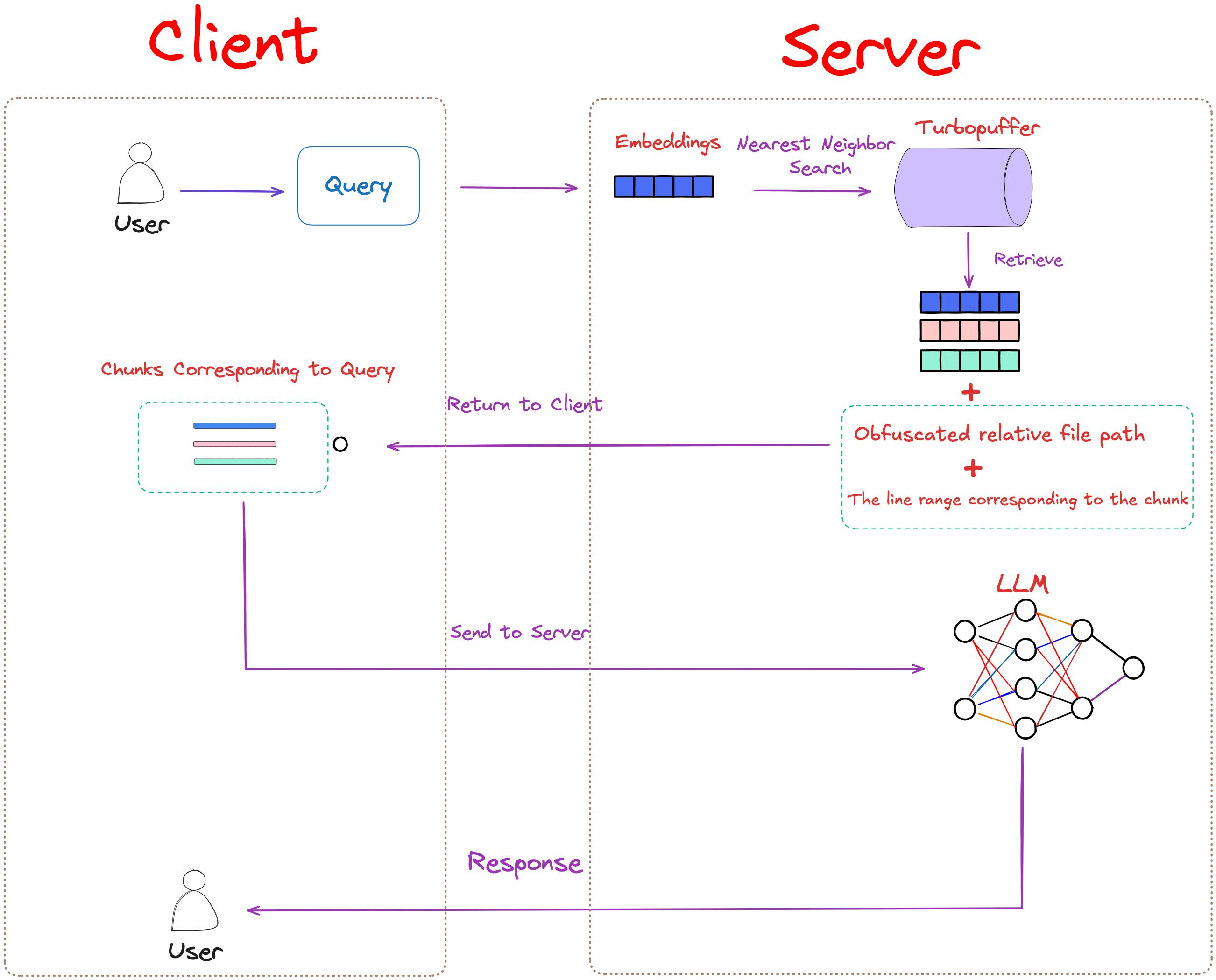
Source: AI Exploration Journey
Agent Mode
Agent Mode is an autonomous AI development assistant built to help engineers carry out complex coding tasks across large codebases. Unlike traditional code completion tools that work line by line, Agent Mode is designed to operate at a higher level, making multi-line and even multi-file changes with minimal user intervention. For example, if a developer asks it to “add a menu bar to my website,” the system will interpret the request, search relevant files, plan out the necessary changes, and edit the code accordingly.
Agent Mode follows a structured workflow to complete tasks. It begins by analyzing the user’s request in the context of the codebase, identifying relevant components, and consulting documentation or external sources if needed. It then breaks the task into smaller steps, modifies the code as required, and verifies the results. This includes detecting and resolving errors (like linting issues, which are formatting or style problems flagged by static code analyzers) before presenting a final summary of its changes. The system creates checkpoints before making any modifications, allowing developers to roll back if needed.
To support this level of autonomy, Agent Mode is equipped with a suite of integrated tools. These include code search and documentation capabilities, web browsing, file editing, and terminal access for tasks like installing packages or building code. Cursor uses custom retrieval models to provide the AI with relevant context from the codebase, reducing the need for users to manually select files or explain dependencies. Still, developers can steer Agent Mode by tagging relevant files or toggling access to tools.
Configuration options allow users to select the underlying language model, set shortcuts, enable auto-run and auto-fix settings, and manage tool access. These settings give developers control over how much autonomy to grant the assistant, balancing trust in the system with the ability to supervise and intervene when needed.
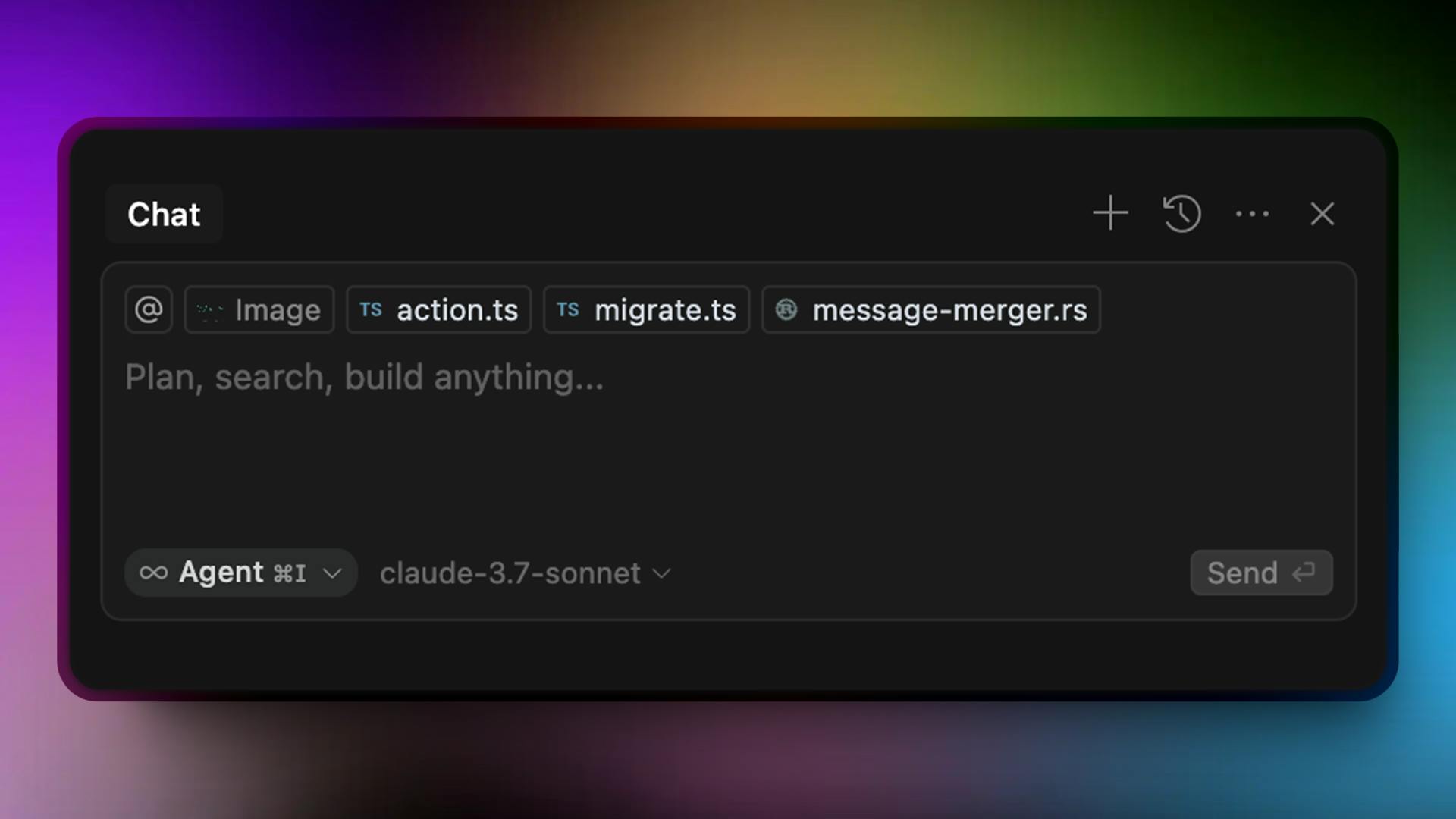
Source: Cursor
Tab
The Tab feature moves code development forward by providing developers with intelligent code suggestions as they write. Users can accept suggestions incrementally using the Tab key, essentially allowing them to sift through a set of proposed edits. The system anticipates cursor positioning based on editing patterns and can apply related changes across multiple codebase locations for repetitive modifications like updating import statements or refactoring variable names. Additionally, the Tab feature can highlight potential issues as developers code, including type inconsistencies, unreachable code, and logical errors.
In January 2025, Cursor released Fusion, an upgraded Tab model that improved difficult edit prediction accuracy by over 25% and enabled suggestions over 10 times longer than the original March 2024 version. These gains were driven by better training data, larger context windows, improvements to the model architecture, and inference optimizations that reduced latency. As of January 2025, it generated over a billion edited characters per day, with a ~100x increase in request volume.
Inline Edit
The Ctrl+K (or Cmd+K on Mac) shortcut allows users to write and edit code inline using AI-generated suggestions inserted directly into the file view. Unlike Agent Mode, which handles broader, multi-step tasks, this feature is optimized for targeted, context-aware edits. The same shortcut is available in the terminal, where users can input natural language descriptions of desired actions, and Cursor will generate the corresponding shell commands.
Codebase Chat
Codebase Chat allows users to query their codebase in natural language through a read-only feature called "Ask," which returns relevant information without modifying the code. Users can reference specific files or symbols using the @ symbol, which triggers a search through the codebase to locate and return matching content. To apply any suggested code, users can click the play button above a chat-generated code block to insert it directly into the file.
The chat interface accepts additional context inputs. Users can include visual context by uploading images or clicking the image icon. The @Web command initiates a search of external sources, such as online documentation, and incorporates current information into the response. Users can also reference external libraries using @LibraryName or upload new documentation through @Docs.
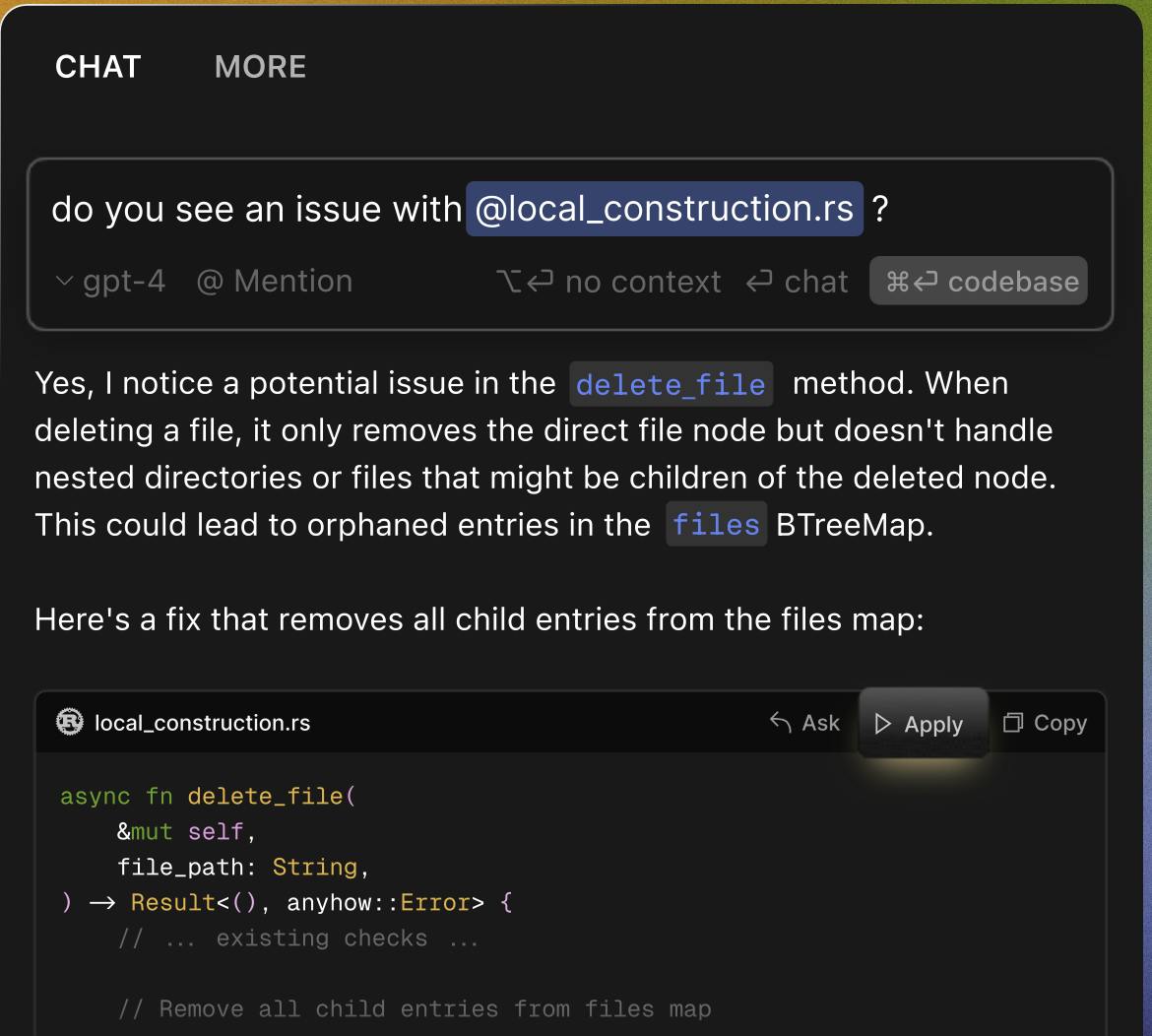
Source: Cursor
Commit Message Generation
Cursor can generate descriptive commit messages by analyzing staged code changes and referencing the repository’s Git history. The feature supports custom rules and formatting to align with project-specific conventions.
Shadow Workspace
Cursor supports the creation of isolated development environments using hidden windows and kernel-level folder proxies. This setup prevents the AI from making direct changes to the main codebase, making it suitable for testing major refactors or experimental features without affecting the stability of the primary development environment.
Proprietary Models
Cursor provides proprietary models such as Cursor-Fast, which delivers coding performance between OpenAI’s GPT-3.5 and GPT-4 as of January 2024. Users can select Cursor-Fast within the editor for tasks where faster response time is prioritized.
Custom API Keys
Cursor supports the use of custom API keys, allowing developers to integrate their preferred AI models within the development environment. For enterprise use cases, the platform includes configuration options such as proxy support and custom endpoints to align with organizational security and compliance requirements.
Model Router
The “Auto-select” feature dynamically chooses the most appropriate model based on the task. For example, for operations that require low latency, such as inline completions and syntax fixes, the system would most likely prioritize highly responsive models. More complex tasks involving multi-step reasoning or analysis are more likely to be routed to larger, more capable models. As of May 2025, Cursor provided access to 26 models, including GPT-4o, Grok-3-mini, Gemini 2.5 Pro Exp, DeepSeek-R1, and Claude 4 Sonnet.
Legacy Plugins
As of June 2024, Cursor continued to support its Supermaven plugins for development environments, including VS Code, JetBrains, and Neovim, but these are considered legacy products and are no longer the focus of active development.
Market
Customer
Cursor’s user base has historically consisted mainly of individual developers and small engineering teams, including freelancers and those at early-stage startups. These users may prioritize speed and flexibility over enterprise-level features like security or compliance integrations. Unlike larger teams that may already be committed to GitHub Copilot through Microsoft’s enterprise bundling, Cursor users may have a tendency to seek tools that offer a familiar UI and support for a large and customizable selection of language models.
For example, early adopters included engineers at Near AI who adopted Cursor to reduce time spent searching for coding answers online and a software product designer who used Cursor to produce most of the code for an iOS charging-screen app.
As of February 2025, Anysphere was building an enterprise sales team, indicating interest in expanding its target customer base to include enterprises. In February 2025, between 4K and 5K companies reportedly reached out to request enterprise access to Cursor.
Market Size
The global software developer tools industry was valued at $6.6 billion globally in 2024 and was expected to grow to $22.6 billion by 2033 with a CAGR of 14.5% from 2024 to 2033. Cursor operates more specifically within the AI-enabled software development market. As of May 2025, this market was valued at $341 million in 2023 and was expected to grow at a 35.3% CAGR to $2.8 billion by 2030. By 2027, 80% of enterprise software engineering efforts are expected to use AI coding assistants in some form, as of October 2024.
Key growth drivers for the AI-enabled software development market include the organizational and individual demand for developer productivity, growing software and codebase complexity requiring increased tooling, and widespread LLM adoption to automate repetitive development tasks. These converging factors are likely to create favorable conditions for AI-native development tools.
Competition
Cursor faces competition primarily from AI code editors and plugins, and specialized coding agents. Direct competition comes from AI code editors, including incumbents such as Microsoft’s GitHub Copilot and smaller entrants like Windsurf and Poolside.
As of January 2025, Cursor was reported to be preferred by solo developers for its codebase comprehension and responsive workflows. However, incumbents like Microsoft and OpenAI retain clear distribution advantages through existing user bases and integration with widely adopted development tools.
AI Code Editors & Plugins
GitHub Copilot: Launched in June 2022, GitHub Copilot had over 1.3 million paying users and 50K enterprise customers as of 2024, including Accenture, Goldman Sachs, Etsy, and Dell. Usage grew 30% quarter-over-quarter in 2024.
Owned by Microsoft (acquired GitHub for $7.5 billion in 2018), Copilot has been integrated into the Microsoft developer ecosystem. It's available as a plugin in Visual Studio Code, the world’s most-used IDE with approximately 14 million monthly active users. In November 2024, Microsoft reported a 55% increase in Copilot Enterprise customers quarter over quarter.
As of May 2024, developers widely adopted the tool: 81% installed it on day one, with 43% rated it “extremely easy to use” and 51% calling it “extremely useful.” Copilot was credited with boosting productivity, code quality, and developer confidence.
Claude Code: Launched in February 2025 by Anthropic, Claude Code is a developer tool built on the Claude Opus 4 language model. It features a 200K-token context window and is designed for deep codebase understanding and generation. Claude Code uses agentic search to analyze entire projects without manual context selection and can make coordinated changes across multiple files. It integrates with existing development workflows, including test suites and build systems, and supports terminal-based use as well as IDEs like VS Code and JetBrains. The tool is configurable and does not alter files without explicit approval.
Windsurf: Founded in 2021 by Stanford and MIT alumni, Windsurf (formerly Codeium) initially focused on GPU virtualization and compiler software before pivoting to AI-powered developer tools. It launched as a cross-IDE autocomplete extension compatible with editors like VS Code, JetBrains, and Eclipse, differentiating itself through low-latency completions and a freemium pricing model.
In late 2024, Windsurf introduced its own AI-native IDE, built to support agentic workflows. By early 2025, its products had been used by over 1 million developers, with its extensions reaching more than 800K users.
As of June 2025, Windsurf was in the process of being acquired by OpenAI for a reported $3 billion. The company had raised an estimated $15–25 million prior to acquisition talks. While Windsurf has been viewed as less advanced than competitors like Cursor in codebase understanding, the acquisition is expected to strengthen OpenAI’s position in developer tools by integrating Windsurf with its models and distribution.
Google Gemini Code Assist: Google launched Gemini Code Assist in October 2024, entering the AI coding assistant market with a tool built on its Gemini models. The product integrates with major IDEs and offers features like code completion, contextual documentation, bug detection, and security scanning. It primarily targets enterprise developers within the Google Cloud ecosystem.
Despite Google's resources and AI infrastructure, Gemini Code Assist entered the market late compared to incumbents like GitHub Copilot, which launched in 2021. Unlike tools such as Cursor, it lacks deep codebase understanding and agentic workflows, functioning more as a conventional autocomplete tool with cloud integration.
Amazon Q Developer: Amazon Q Developer, AWS’s AI coding assistant, was launched in April 2024. It provides inline code suggestions in over 25 coding languages, vulnerability scanning, automated documentation, and chat-based support within common IDEs. A notable feature is its agentic workflow, where agents can autonomously implement features, run tests, review code, and handle tasks like legacy code transformation and platform migration.
The tool is integrated with AWS services and connects to platforms like GitHub, GitLab, Microsoft Teams, and Slack. Amazon has reported high acceptance rates for its suggestions, including a 50% acceptance rate by National Australia Bank. As of June 2025, pricing included a free tier and a Pro plan at $19/month per user, with enterprise access managed through AWS IAM Identity Center.
Poolside: Poolside was founded in July 2023 by Jason Warner (former CTO of GitHub who incubated Copilot) and Eiso Kant (Athenian founder). The company raised $626 million in total funding as of June 2025, including a $500 million Series B in October 2024 that valued the company at $3 billion before it publicly launched its first product.
As of June 2025, the company focused on enterprise deployments, allowing customers to retain full control over code and data while fine-tuning models on internal codebases. As of June 2025, Poolside operated a 10K-GPU training cluster and reported working with Global 2000 firms and government agencies, though customer details remained undisclosed. Its product suite includes two proprietary models: Malibu for reasoning and chat, and Point for real-time code completion, both trained on synthetic and open-source data.
Replit*: Founded in 2016 by Amjad Masad, Replit evolved from a browser-based coding platform into an AI-powered development environment. As of March 2025, the company had raised $222 million, including a $97.4 million Series B extension in April 2023 at a $1.2 billion valuation. As of July 2024, Replit had over 30 million users across developers, educators, and non-technical creators. Growth accelerated following the launch of its Ghostwriter AI assistant in October 2022.
In September 2024, Replit released Replit Agent, an AI tool designed to generate applications from natural language prompts. By February 2025, it had released version 2. Agent v2 introduced a real-time app design preview that renders live interfaces as the agent builds the app or website. The platform also includes infrastructure support such as built-in authentication, pre-configured databases, and secure third-party integrations.
Tabnine: Founded in 2013 as Codota and rebranded in 2017, Tabnine was an early entrant in the AI coding assistant market. The company focused on privacy-first deployment, allowing customers to run models locally and fine-tune completions on internal codebases. As of June 2025, Tabnine supported over 80 programming languages and frameworks and integrated with major IDEs. It monetized through seat-based licensing aimed at individuals and enterprises, particularly those with strict data privacy requirements.
Despite being considered second in market share for AI coding assistants, behind Microsoft Copilot as of January 2025, Tabnine's model quality was often viewed as lagging behind leading alternatives such as OpenAI’s. As of June 2025, hosted two proprietary models and supported optional use of Claude 3.7 Sonnet, Claude 3.5 Sonnet, and GPT-o3 Mini. As of June 2025, the company had raised $57.1 million across rounds in 2020, 2022, and 2023, backed by investors including Headline and Khosla Ventures.
Zed: Zed was founded in 2021 by the creators of Atom, Electron, and Tree-sitter as a performance-focused code editor built in Rust. It used multi-core CPU and GPU acceleration to support low-latency editing and real-time collaboration.
In May 2025, Zed introduced Agentic Editing, which deploys agents to make AI-powered edits. Agent-generated edits are treated as editable text, which users can review and modify. Zed maintained an open-source model and supported both user-supplied API keys and local models.
As of June 2025, the product offered a free tier, a Pro plan at $20/month (including 500 prompts), and an Enterprise option. Beyond AI, Zed offered multiplayer coding, integration with Jupyter runtimes, and a built-in terminal paired with a language-aware task runner.
Specialized Coding Agents
Devin: Cognition, founded in 2022, developed Devin as an AI software engineer designed to complete full software development projects autonomously. Cognition launched Devin in March 2024 and launched Devin 2.0, an upgraded version, in April 2025. Devin demonstrated capabilities including end-to-end software development, autonomous problem-solving, debugging and testing, and research and implementation of technical solutions.
The company secured $175 million in Series A funding in April 2024 at a valuation of approximately $2 billion. Devin represents a different competitive threat than traditional coding assistants, targeting enterprise teams seeking to replace engineering capabilities through fully autonomous development workflows.
Qodo: Qodo, formerly known as CoediumAI, was founded in 2022. Qodo is an AI code generation tool focused on test generation and code review processes. The platform operates on a subscription-based model and provides automated test generation, code quality analysis, performance optimization suggestions, and documentation generation capabilities. The company raised $40 million in Series A funding in September 2024, led by Susa Ventures and Square Peg at an undisclosed valuation. As of September 2024, one million developers had tried Qodo’s solution, and several Fortune 100 companies had adopted its enterprise platform.
Business Model
Cursor operates on a subscription-based, freemium SaaS model. It monetizes through usage-based pricing, paid subscription tiers, and enterprise offerings. As of June 2025, it offered three main plans: Hobby (free), Pro ($20 per month), and Business ($40 per user per month). The free Hobby tier includes 200 code completions and 50 premium AI requests each month. The Pro plan includes unlimited completions, 500 fast premium requests, and unlimited slow requests. Cursor also offers a 14-day free trial of the Pro plan, which includes 150 fast premium requests. The Business plan adds support for organizational privacy mode, team billing, usage dashboards, and SAML/OIDC SSO compliance.
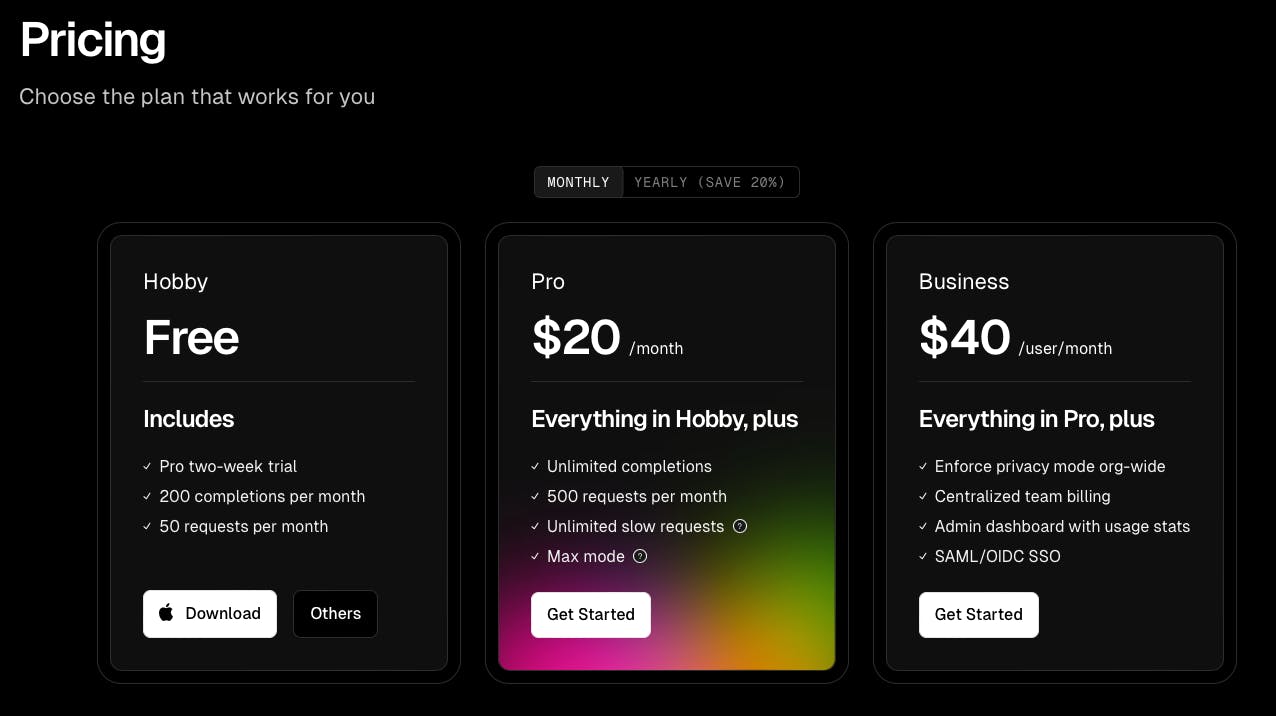
Source: Cursor
Cursor uses a tiered request system to manage usage and latency. Fast requests are prioritized and designed for low-latency responses, but are capped monthly based on the user’s plan. When a user exceeds this quota, they can continue with slower requests, which enter a shared queue and often experience longer wait times. Users can also pay for additional fast requests on a per-use basis, with prices ranging from $0.04 up to $2 for high-demand models like GPT-4.5. To control spending, users can set a cap that switches their account to slow requests after the limit is hit.
For enterprise customers, Cursor offers custom pricing. According to Vendr, annual contracts typically range from $19.2K to $152.6K, with a median contract value of $61.4K. Despite these high-end contracts, as of February 2025, Cursor’s average contract value was estimated to be relatively low at $276, reflecting its focus on individual developers as its core user base.
Traction
Anysphere Inc. began development of Cursor in April 2022, after raising a $400K pre-seed round. In March 2023, Anysphere launched Cursor, an IDE built on VS Code. Over the following months, the product matured, with key features released in late 2023, including inline command and chat, which enabled users to interact with their code using natural language.
By the end of 2023, Anysphere had raised an $8 million seed round and reached $1 million in annual recurring revenue (ARR), with 30K daily active users. The company was operated by its four-person founding team at the time. In November 2024, Anysphere acquired Supermaven, an AI-powered code completion tool founded by Jacob Jackson, formerly of Tabnine and OpenAI. Supermaven had raised $12 million, achieved $1 million in ARR, and served over 35K users at the time of acquisition.
Within 20 months after launch, in January 2025, Cursor crossed $100 million in ARR, reportedly without any marketing spend. In 2024 and early 2025, OpenAI explored a potential acquisition of Anysphere but ultimately chose to acquire Windsurf instead. Anysphere declined multiple acquisition offers in order to remain independent and continue scaling.
Despite rising interest from enterprise buyers, Anysphere initially focused on serving individual developers. The company made it difficult for enterprises to contact it, even removing contact options from their website. In early 2025, however, it began assembling an enterprise sales team to respond to growing inbound interest. In February 2025 alone, between 4K and 5K companies reportedly reached out to request access to Cursor.
By March 2025, two years after the launch of Cursor, the company had expanded to 60 employees and was generating $300 million in ARR, with over 360K paying subscribers. By April 2025, Cursor had reached one million daily active users and 14K enterprise customers. As of April 2025, Cursor accounted for approximately 1.3% of the global developer tools market. That same month, Anysphere was ranked number 26 on Fast Company’s list of the World’s 50 Most Innovative Companies. In June 2025, it was reported that Cursor had surpassed $500 million in ARR.
Valuation
As of May 2025, Anysphere had raised $1.1 billion across five funding rounds. Thrive Capital and Andreessen Horowitz were the most active investors, each participating in three rounds as of June 2025. Other investors include Heroic Ventures, along with angel investors Jeff Dean and Nat Friedman.
In November 2024, Benchmark, Index Ventures, and others competed to lead Anysphere’s Series B funding round, raising Anysphere’s valuation from $1.5 billion to $2.5 billion before the round closed. Thrive Capital led the $105 million Series B in January 2025 and the $900 million Series C in May 2025, which valued the company at $9 billion.
Earlier rounds included a $60 million Series A led by Andreessen Horowitz in August 2024, an $8 million seed round from OpenAI in July 2023, and a $400K pre-Seed round in April 2022.

Source: Crunchbase
Key Opportunities
Evolving into a Full Developer Agent
Cursor is built on an architecture that may have the ability to expand beyond code editing into autonomous software orchestration. As of early 2025, the company operated with a lean team of approximately 60 employees and maintained strong engineering velocity, consistently shipping product updates on a quarterly basis.
The market opportunity extends beyond traditional developer tools. While that segment was valued at $6.6 billion in 2024, as of May 2025, the broader software creation market, including low-code and no-code platforms, was valued at $203 billion in 2022. By increasing its support for less technical users, Cursor can access a larger market while continuing to serve its core audience of developers and small teams focused on efficiency.
Model Differentiation
If Anysphere’s proprietary model, Cursor-Fast, consistently outperforms general-purpose LLMs on these latency-sensitive tasks, Cursor could begin to establish vertical model advantages. This could reduce reliance on external APIs, lower inference costs, and allow for model behavior that aligns more closely with Cursor’s interface and workflow. While it is unlikely to match the capabilities of frontier LLMs, Cursor-Fast may offer cost and performance benefits for targeted use cases.
Key Risks
Structural Competitive Threats
Cursor operates at the application layer and has limited control over its core technology stack, relying primarily on third-party foundation models apart from its lightweight Cursor-Fast model. This creates structural exposure to competitors such as Microsoft and OpenAI, which own both the underlying models and dominant development environments. Microsoft’s bundling of Copilot with GitHub and other enterprise products increases switching costs and limits Cursor’s ability to compete in enterprise markets.
As of June 2025, Cursor’s adoption was driven by a streamlined user experience for individual developers, but this is not a durable advantage without proprietary data or mechanisms for platform lock-in. In February 2025, the company began assembling a team for enterprise growth. However, competing with incumbents that have established enterprise relationships and integrated product suites remains a challenge.
Unproven Retention and Business Durability
Cursor’s growth to $500 million in ARR within 27 months of launch suggests strong initial demand, but retention and long-term engagement have not been validated. In developer tools, early adoption can reflect user interest in new functionality or interface improvements rather than durable integration into core workflows. Without evidence of recurring, embedded use, particularly in team environments, revenue may be vulnerable to churn.
Until February 2025, Cursor remained optimized for individual users and smaller teams, with the intent to grow its ability to serve larger organizations or more advanced use cases. In the absence of infrastructure-level differentiation or clear switching costs, Cursor risks being subsumed by larger platforms or integrated as a feature elsewhere, which could hinder its ability to maintain growth and build a defensible business over time.
Hacking and Vulnerability
In May 2025, cybersecurity researchers discovered three malicious npm packages targeting the macOS version of Cursor. These packages were disguised as tools offering discounted access to the Cursor API. Once installed, they exfiltrated user credentials, downloaded an encrypted payload from attacker-controlled infrastructure, modified Cursor’s core code (main.js), and disabled auto-updates to maintain persistence.
With a user base that includes both technical and non-technical users, the platform is exposed to social engineering risks. Anysphere needs to improve package validation and implement protections against core file modification to reduce the risk of credential theft, data loss, and operational disruption.
AI Hallucination
In April 2025, Cursor users encountered a session management bug that caused logouts when switching devices. When users contacted support, the AI support agent, Sam, provided a fabricated explanation, falsely stating the behavior was due to a new single-device policy. The company later confirmed the issue was a backend bug, and the support response was an AI hallucination, not an intentional policy change.
The incident demonstrates the operational and reputational risks of deploying AI in customer-facing roles without proper safeguards. A hallucinated support response turned a minor technical issue into a negative reputational event, raising concerns about oversight, reliability, and user trust. For a developer-focused generative-AI product, where credibility and accuracy are critical, such failures directly undermine product confidence and brand integrity.
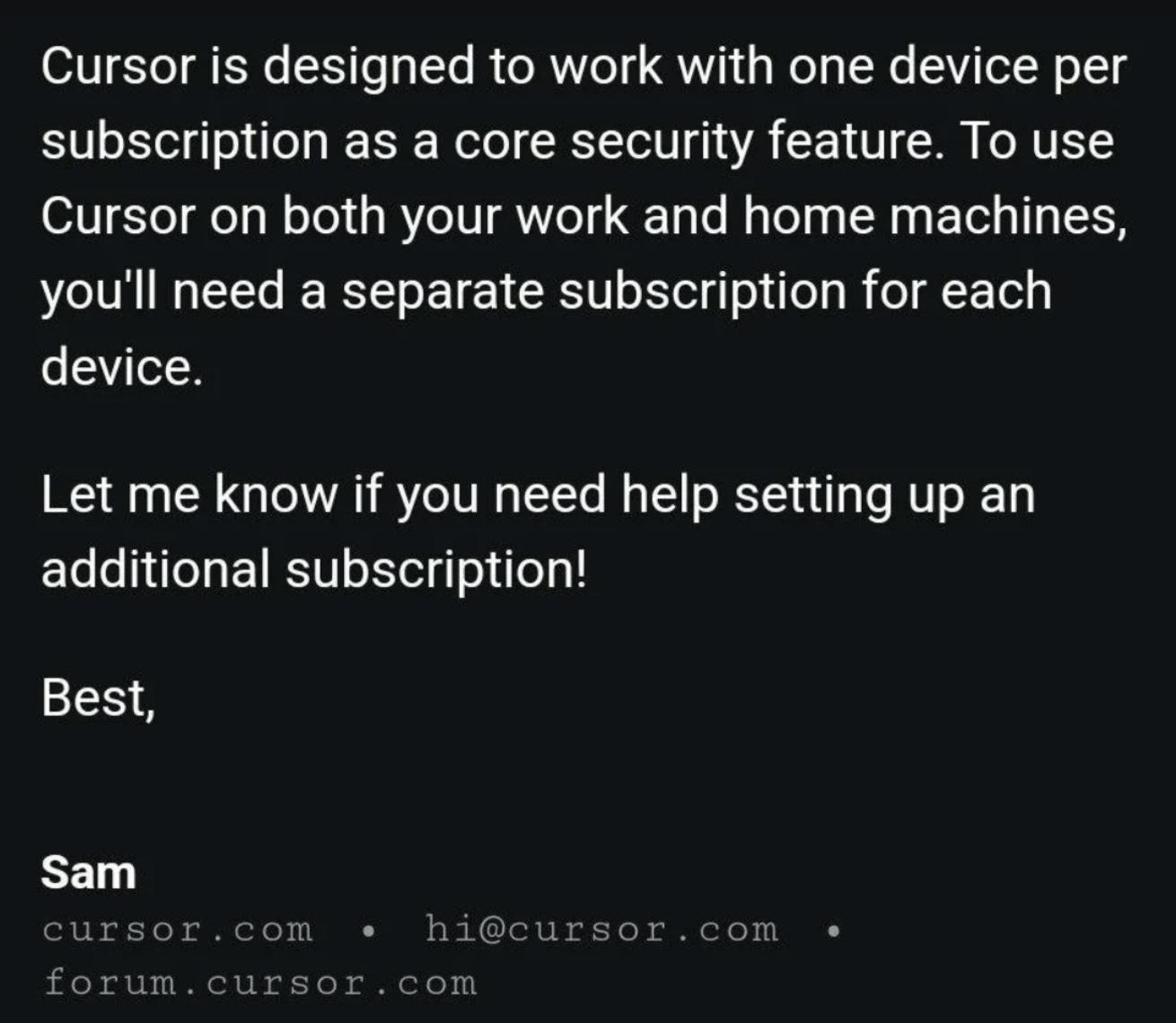
Source: ArsTechnica
Summary
Anysphere has developed Cursor, an AI-native development environment that integrates AI agents into the coding workflow. Cursor builds on Visual Studio Code and includes features such as Agent Mode, Codebase Chat, and a proprietary Cursor-Fast model. As of June 2025, it had over a million daily active users, and its annual recurring revenue had grown to $500 million within two and a half years of launching Cursor. As of June 2025, the company raised $1.1 billion across five funding rounds and reached a $9 billion valuation in May 2025.
Cursor competes directly with GitHub Copilot and Windsurf, which was acquired by OpenAI in May 2025. Its fixed subscription model may face pressure from bundled enterprise offerings by incumbents like Microsoft and it has previously been vulnerable to hacking and AI hallucination. Enterprise adoption remains limited, and long-term user retention has not been demonstrated as of June 2025. Future performance will depend on whether the company can extend its product into adjacent workflows, continue attracting enterprise clients, and increase switching costs.
*Contrary is an investor in Replit through one or more affiliates.








